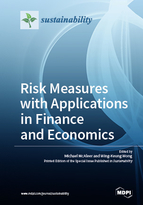Risk Measures with Applications in Finance and Economics
A special issue of Sustainability (ISSN 2071-1050).
Deadline for manuscript submissions: closed (31 July 2018) | Viewed by 138950
Special Issue Editors
Interests: economics; financial econometrics; quantitative finance; risk and financial management; econometrics; statistics; time series analysis; energy economics and finance; sustainability; environmental modelling; carbon emissions; climate change econometrics; forecasting; informatics; data mining
Special Issues, Collections and Topics in MDPI journals
2. Department of Medical Research, China Medical University Hospital, Taichung City 40447, Taiwan
3. Department of Economics and Finance, The Hang Seng University of Hong Kong, Hong Kong, China
Interests: behavioral models; mathematical modeling; econometrics; energy economics; equity analysis; investment theory; risk management; behavioral economics; operational research; decision theory; environmental economics; public health; time series analysis; forecasting
Special Issues, Collections and Topics in MDPI journals
Special Issue Information
Dear Colleagues,
Risk Measures play a vital role in many fields in Economics and Finance. Using different risk measures could compare the performances of different variables through the analysis of empirical real-world data. For example, risk measures could help to form effective monetary and fiscal policies, and to develop pricing models for financial assets, such as equities, bonds, currencies, and derivative securities.
A Special Issue of “Risk Measures with Applications in Finance and Economics” will be devoted to advancements in the mathematical and statistical development of risk measures with applications in Finance and Economics. This Special Issue will bring together theory, practice and applications of risk measures.
We invite investigators to contribute original research articles in theory and applications of risk measures. All submissions must contain original unpublished work not being considered for publication elsewhere.
Chair Prof. Michael McAleer
Chair Prof. Wing-Keung Wong
Guest Editors
Manuscript Submission Information
Manuscripts should be submitted online at www.mdpi.com by registering and logging in to this website. Once you are registered, click here to go to the submission form. Manuscripts can be submitted until the deadline. All submissions that pass pre-check are peer-reviewed. Accepted papers will be published continuously in the journal (as soon as accepted) and will be listed together on the special issue website. Research articles, review articles as well as short communications are invited. For planned papers, a title and short abstract (about 100 words) can be sent to the Editorial Office for announcement on this website.
Submitted manuscripts should not have been published previously, nor be under consideration for publication elsewhere (except conference proceedings papers). All manuscripts are thoroughly refereed through a single-blind peer-review process. A guide for authors and other relevant information for submission of manuscripts is available on the Instructions for Authors page. Sustainability is an international peer-reviewed open access semimonthly journal published by MDPI.
Please visit the Instructions for Authors page before submitting a manuscript. The Article Processing Charge (APC) for publication in this open access journal is 2400 CHF (Swiss Francs). Submitted papers should be well formatted and use good English. Authors may use MDPI's English editing service prior to publication or during author revisions.







